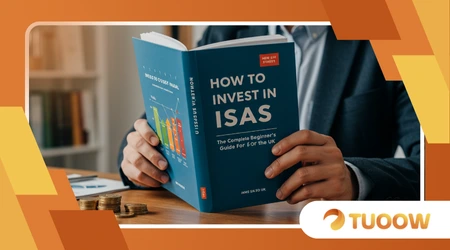How to Invest in ISAs: The Complete Beginner’s Guide for the UK

How to invest in ISAs is a phrase that sparks curiosity for anyone looking to grow their wealth tax-free in the UK.
Individual Savings Accounts (ISAs) are a cornerstone of personal finance, offering a shield against taxes on savings and investments.
With a £20,000 annual allowance in 2025, they’re a powerful tool for beginners and seasoned investors alike.
This guide dives deep into the world of ISAs, unpacking their types, benefits, and strategies with a fresh perspective.
Whether you’re starting with a modest sum or aiming to maximize returns, we’ll navigate the landscape with clarity, practical examples, and smart insights.
Let’s explore how you can make your money work harder, tax-free, in today’s dynamic financial environment.
ISAs aren’t just about stashing cash; they’re about building a future with flexibility and foresight.
Recent debates, like Chancellor Rachel Reeves’ push for more equity investments, highlight their evolving role.
This guide will demystify how to invest in ISAs, offering actionable steps for beginners. From choosing the right ISA to avoiding common pitfalls, we’ll cover it all with a human touch, steering clear of jargon-heavy traps.
Ready to take control of your financial journey? Let’s dive in.
What Are ISAs and Why Should You Care?
An ISA is a tax-free savings or investment account available to UK residents. Your gains whether interest, dividends, or capital growth escape HMRC’s grasp.
In 2025, the £20,000 allowance lets you save or invest flexibly. Why does this matter? Because taxes erode returns, and ISAs preserve every penny of your growth.
Imagine your savings as a garden. Taxes are weeds, nibbling away at your blooms. ISAs act like a protective fence, letting your wealth flourish.
This analogy underscores their value: tax-free growth compounds over time, turning small seeds into mighty oaks. For beginners, this is a game-changer.
But not all ISAs are equal. Cash ISAs suit risk-averse savers, while Stocks and Shares ISAs appeal to those chasing higher returns.
++ Bank of England Cuts Rates: What It Means for British Finances in 2025
Lifetime ISAs and Junior ISAs cater to specific goals. Understanding these options is your first step to mastering how to invest in ISAs.
The ISA landscape is shifting. Recent government talks suggest reforms to encourage stock market investments, potentially reshaping Cash ISA allowances.
Staying informed is crucial. ISAs aren’t just accounts; they’re strategic tools for wealth-building in an uncertain economy.

Types of ISAs: Which One Fits Your Goals?
Navigating the ISA family can feel like choosing a dish at a new restaurant. Each type has unique flavors, suited to different appetites.
Let’s break down the main options for 2025, so you can pick the one that aligns with your financial goals.
Cash ISAs are the safe bet, like a cozy savings account with tax-free interest. They’re ideal for emergency funds or short-term goals.
In 2025, top rates hover around 4.5%, though they fluctuate with Bank of England policies. Perfect for cautious beginners, but returns may lag inflation.
Stocks and Shares ISAs offer adventure, letting you invest in shares, funds, or bonds. They’re riskier but promise higher long-term gains.
Also read: Essential Tax Deadlines Approaching: Are You Prepared?
For example, Sarah, a 30-year-old teacher, invests £5,000 annually in a global equity fund, aiming for 7% average returns. Over 20 years, this could grow significantly, tax-free.
Lifetime ISAs target first-time homebuyers or retirement savers aged 18-39. You can save £4,000 yearly, with a 25% government bonus.
Take Tom, who saves £4,000 annually; the government adds £1,000, boosting his house deposit. But withdrawals for other purposes incur penalties, so plan carefully.
Junior ISAs let parents save £9,000 annually for kids, tax-free. Gains roll over until the child turns 18. Think of it as planting a financial tree for your child’s future slow-growing but sturdy.
Innovative Finance ISAs are niche, focusing on peer-to-peer lending or crowdfunding. They’re high-risk, less common, and not ideal for beginners. Stick to mainstream options unless you’re a seasoned investor.
Recent data from HMRC shows 12 million UK adults used ISAs in 2023-24, with £160 billion invested. This popularity reflects their versatility.
But with potential reforms looming, like combining Cash and Stocks ISAs into a single product, flexibility is key. Choose based on your risk tolerance and timeline.
Each ISA type serves a purpose. Cash ISAs offer security, Stocks and Shares ISAs chase growth, and Lifetime ISAs blend savings with bonuses. Assess your goals short-term safety or long-term wealth and pick wisely.
Getting Started: How to Open an ISA
Opening an ISA is simpler than assembling flat-pack furniture, but it requires focus.
Start by choosing a provider banks, building societies, or investment platforms like AJ Bell or Fidelity. Compare fees, investment options, and ease of use before committing.
You’ll need to be a UK resident, over 16 for Cash ISAs, or 18 for Stocks and Shares ISAs.
Have your National Insurance number handy, along with proof of identity. Most platforms let you apply online in minutes, often with just £100 to start.
Decide how much to invest within the £20,000 limit. For example, you could split £10,000 between a Cash ISA and a Stocks and Shares ISA.
Read more: Interest Rate Hikes: What Savers and Borrowers Need to Know Right Now
Check the provider’s terms some Cash ISAs lock funds for fixed terms, while Stocks and Shares ISAs offer daily access but with market risks.
Don’t rush. Research platforms’ performance history and customer reviews. A 2025 Forbes review praises AJ Bell Dodl for low 0.15% fees, ideal for beginners. Avoid impulse choices; your ISA is a long-term commitment.
Once opened, fund your ISA via bank transfer or debit card. Set up regular contributions, like £200 monthly, to build discipline.
Monitor your account annually to ensure it aligns with your goals, especially with potential ISA rule changes on the horizon.
Strategies for Investing in Stocks and Shares ISAs
How to invest in ISAs smartly, especially in Stocks and Shares ISAs, hinges on strategy, not luck. Markets can be turbulent, but a thoughtful approach minimizes risks and maximizes gains. Let’s explore practical tactics for beginners.
Diversification is your safety net. Spread investments across sectors tech, healthcare, energy and geographies.
For instance, Emma, a 25-year-old graphic designer, allocates £8,000 across a UK equity fund, a US index tracker, and an emerging markets ETF. This cushions her against regional downturns.
Consider low-cost index funds for steady growth. The Xtrackers MSCI World Momentum ETF, for example, averaged 11.6% annual returns over the past decade, far outpacing Cash ISAs’ 1.21%.
They’re beginner-friendly, tracking broad markets without requiring stock-picking expertise.
Pound-cost averaging smooths market volatility. Invest a fixed sum monthly say, £500 regardless of market highs or lows.
This reduces the risk of buying at peak prices. Over time, your average cost per share balances out, as Emma found with her monthly ETF contributions.
Avoid emotional decisions. Markets dip, but panic-selling locks in losses. In 2020, the FTSE 100 crashed 35% during COVID, yet patient investors saw recoveries by 2021. Stay focused on your 5-10 year horizon, not daily fluctuations.
Rebalance annually. If one asset grows disproportionately, sell some to restore your target allocation. This keeps risk in check. With how to invest in ISAs, discipline trumps chasing hot tips.
Don’t ignore fees. High charges erode returns. Platforms like AJ Bell Dodl charge just 0.15% annually, while others may hit 0.45%. Compare costs and prioritize low-fee options to maximize your tax-free growth.
Common Mistakes to Avoid When Investing in ISAs

Stepping into how to invest in ISAs can feel like navigating a maze. Beginners often stumble, but sidestepping these pitfalls keeps your wealth on track. Let’s highlight errors to dodge.
Don’t max out your ISA without a plan. Dumping £20,000 into a single stock risks disaster if it tanks. Diversify across assets to spread risk, like Emma’s multi-fund approach.
Ignoring fees is another trap. A 1% annual fee on a £10,000 ISA costs £100 yearly, compounding losses. Always check platform and fund charges before committing.
Chasing past performance is tempting but flawed. A fund soaring in 2024 may flop in 2025. Research fundamentals management, holdings, strategy rather than betting on yesterday’s winners.
Failing to review your ISA annually is a silent killer. Markets shift, and so should your strategy. A 2025 Telegraph report notes potential Cash ISA reforms, urging savers to stay vigilant. Adapt or risk stagnation.
Withdrawing funds carelessly can hurt. Lifetime ISAs charge a 25% penalty for non-qualifying withdrawals. Plan your access needs to avoid costly surprises, like Tom’s careful homebuying strategy.
Tax Benefits and Limits: Maximizing Your ISA
ISAs shine because of their tax-free status, but understanding their limits is crucial. You pay no tax on interest, dividends, or capital gains within an ISA. This is a massive win for wealth-building.
The 2025 allowance is £20,000 per adult, and £9,000 for Junior ISAs. You can split this across ISA types, but not exceed the total.
For example, £12,000 in a Cash ISA and £8,000 in a Stocks and Shares ISA works fine.
| ISA Type | Annual Limit (2025) | Key Benefit | Best For |
|---|---|---|---|
| Cash ISA | £20,000 | Tax-free interest | Short-term savings, low risk |
| Stocks and Shares ISA | £20,000 | Tax-free growth and dividends | Long-term wealth, higher risk |
| Lifetime ISA | £4,000 | 25% government bonus | First home or retirement |
| Junior ISA | £9,000 | Tax-free growth for kids | Long-term child savings |
Don’t waste your allowance. Unused portions don’t roll over. If you can’t invest the full £20,000, start small £50 monthly adds up. Consistency beats procrastination.
Tax savings compound over time. A £10,000 Stocks and Shares ISA growing at 7% annually could double in 10 years, all tax-free.
Outside an ISA, capital gains tax (10-20%) would nibble away. How to invest in ISAs wisely means leveraging this tax shield fully.
Be mindful of rules. You can’t pay into multiple ISAs of the same type in one tax year. Choose one Cash ISA, one Stocks and Shares ISA, and so on. Stay compliant to avoid penalties.
The Future of ISAs: What’s on the Horizon?
The ISA landscape is evolving, with 2025 bringing potential reforms. Chancellor Rachel Reeves has signaled a push for more equity investments to boost UK markets.
This could mean changes to Cash ISA allowances or new hybrid ISAs combining cash and stocks.
Why the shift? The government wants to channel the £300 billion in Cash ISAs into productive investments, like UK businesses. But banks warn this could limit savers’ flexibility, especially for retirees relying on cash.
Proposed changes include a “British ISA” for investing in UK firms, offering an extra £5,000 allowance.
While not yet confirmed, it could appeal to patriotic investors. However, critics argue mandating UK equities risks limiting diversification.
For beginners, this underscores the need to stay informed. A single ISA product, as suggested by experts, could simplify how to invest in ISAs but reduce choice.
Monitor government consultations to adapt your strategy.
Flexibility is your ally. If reforms favor stocks, consider shifting some Cash ISA funds to equities. But balance risk don’t abandon the safety of cash entirely. The future rewards those who plan ahead.
Practical Tips for Long-Term ISA Success
Mastering how to invest in ISAs requires patience and strategy. Start small, but start now. Even £100 monthly in a Stocks and Shares ISA grows over decades.
Set clear goals. Are you saving for a home, retirement, or your child’s future?
Tailor your ISA choice to your timeline. Lifetime ISAs suit homebuyers; Stocks and Shares ISAs fit long-term growth.
Automate contributions. Setting up a £200 monthly direct debit builds discipline. It’s like brushing your teeth routine breeds results. Over 20 years, this could amass a significant nest egg.
Stay educated. Read platforms like MoneyFacts or The Motley Fool for market insights. Attend free webinars from providers like Fidelity to boost your knowledge. Ignorance is the enemy of growth.
Don’t fear volatility. Markets wobble, but long-term trends favor growth. The FTSE 100’s 12.6% annualized return (with dividends) over five years proves resilience. Stay the course.
Review tax rules yearly. Changes in capital gains tax or ISA allowances can impact your strategy. A proactive approach to how to invest in ISAs ensures you’re always optimized.
Conclusion: Your Path to Tax-Free Wealth
How to invest in ISAs isn’t just a search term it’s a gateway to financial freedom. ISAs offer a rare chance to grow wealth without HMRC’s cut.
From Cash ISAs for safety to Stocks and Shares ISAs for growth, there’s an option for every beginner. The £20,000 allowance in 2025 is your playground use it wisely.
Diversify, avoid high fees, and stay informed about reforms like those hinted by Rachel Reeves.
Your financial journey is personal. Whether you’re saving for a dream home, like Tom, or building wealth, like Emma, ISAs empower you.
Why let taxes chip away at your hard-earned gains? Start small, stay consistent, and let compounding work its magic.
The question isn’t whether you should invest in ISAs it’s why haven’t you started yet? Take the first step today, and your future self will thank you.
Frequently Asked Questions
Q: Can I lose money in a Stocks and Shares ISA?
A: Yes, investments can fall in value. Diversify and focus on long-term growth to mitigate risks. Always research before investing.
Q: How do I transfer an ISA to a new provider?
A: Contact your new provider to initiate a transfer. Don’t withdraw funds yourself, or you’ll lose the tax-free status. It typically takes 15-30 days.
Q: What happens if I exceed the £20,000 ISA limit?
A: HMRC will tax any excess contributions. Monitor your deposits across all ISAs to stay within the annual allowance.
Q: Are ISAs worth it for small investments?
A: Absolutely. Even £50 monthly compounds tax-free over time. Start small, and the tax savings add up, especially in Stocks and Shares ISAs.
